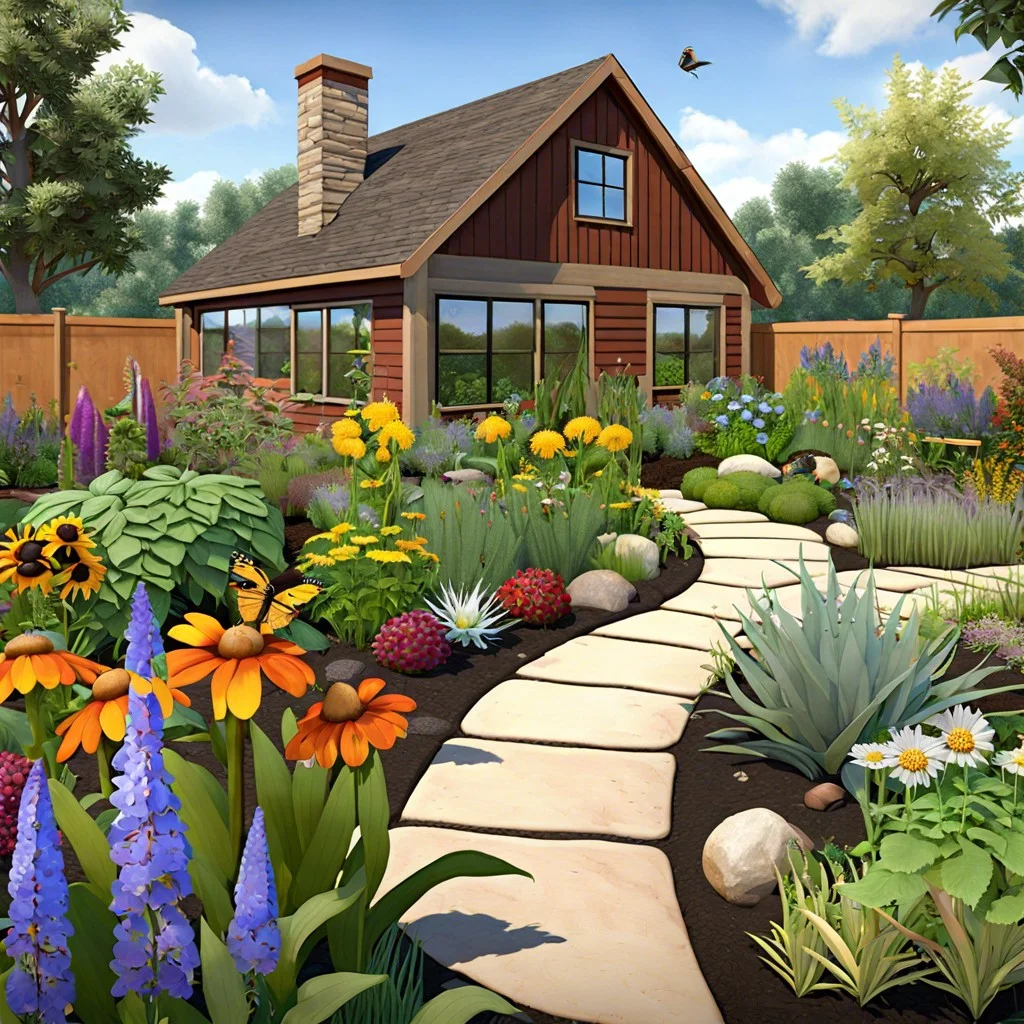Last updated on
Explore these naturally playful ideas because they encompass creativity, sustainability, and styles that rejuvenate your living space like never before.
These are my unique design concepts made using design tools. I hope you find them inspiring!
Prepare to refresh your space with naturally playful ideas that truly stand out. Plenty traditional suggestions are readily available online, yes, but this article aims to push the envelope, bringing to spotlight fresher, unique decor ideas.
So arm yourself with an open mind as we embark on this exciting journey to transform your home with an infusion of natural playfulness.
Furthermore, to ensure you get the most from familiar ideas, resources to stunning examples of well-known styles will be provided at the end.
Let’s dive into this treasury of fresh and engaging ideas – may you find novelty and inspiration in every corner!
What's Inside
Outdoor Art Creations
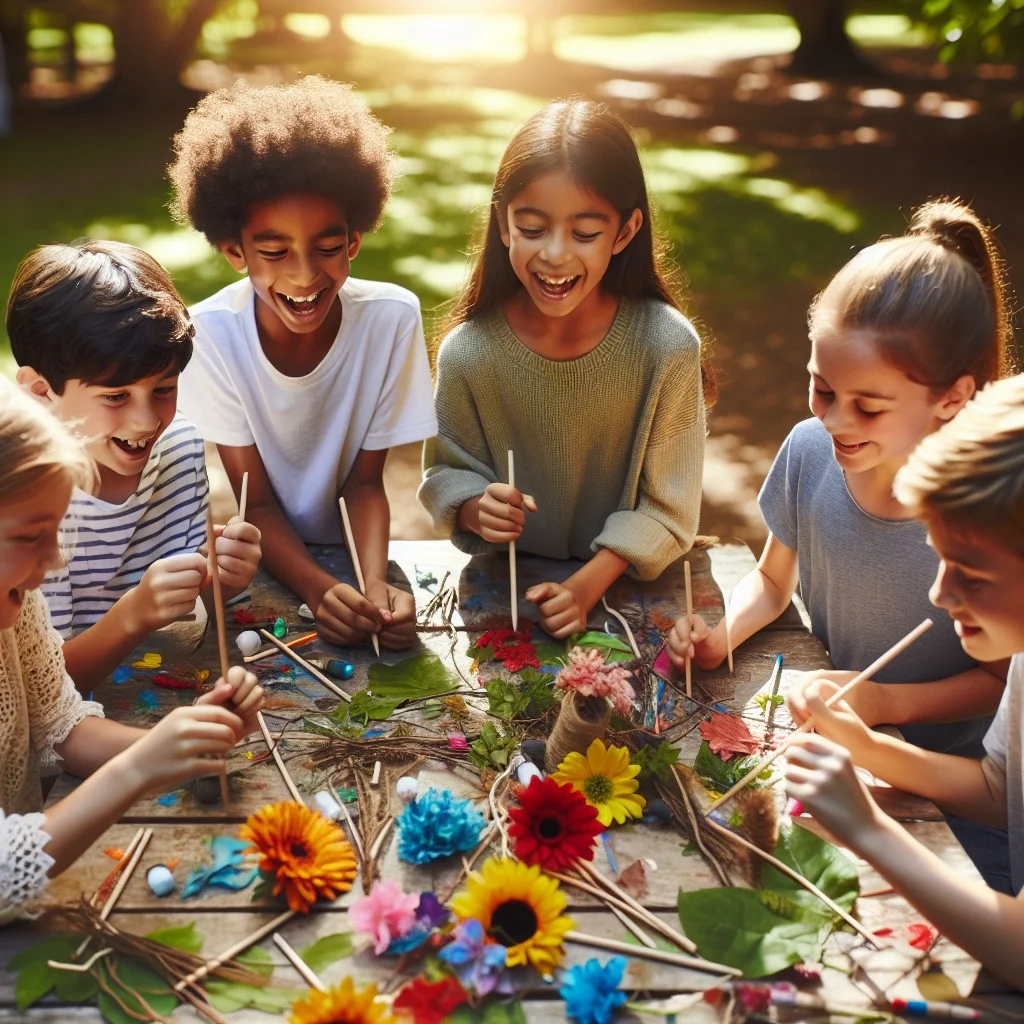
Engaging children in art outdoors presents a unique opportunity for stimulating creativity and fostering an appreciation for nature. Grassy lawns, sandy beaches or back patio can serve as the canvas for your outdoor art creation. Here are a few natural resources to consider:
- Leaves: Collect various sizes, shapes and colors. Use them to make impressions or as part of a collage.
- Rocks: Use for painting or arranging them in patterns or designs.
- Twigs and Sticks: They can be glued together to create structures or figures.
- Mud: Mud painting can provide a rather different, tactile experience, and you can easily wash away your creation when you’re done.
- Flowers and Berries: Can contribute color and interesting textures. Berries can be also used as pigments for painting.
Remember, the ultimate goal isn’t to create a perfect piece of art, but to explore, create and have fun. Don’t forget to respect nature: only use what is abundant and never harm living plants or creatures in your quest for materials.
DIY Natural Musical Instruments

Incorporating nature into your DIY music-making venture nurtures both your creativity and appreciation for the outdoors. Here, the focus is on simplicity and resourcefulness—taking full advantage of the untapped symphony of sound that nature offers.
1. Finger tapping on hollow logs can provide a resonating drumlike effect, perfect for keeping rhythm during impromptu outdoor jam sessions.
2. A bunch of unopened seed pods shaken together act as an impressive substitute for jingle bells or maracas.
3. Various lengths of bamboo stalks can be adhered together, creating a captivating wind chime or a pan flute with a unique sound.
4. By using different sized rocks, you can create a lithophone—type of xylophone using stones—each producing a different pitch when struck.
Always remember to not harm or destruct nature while gathering materials to create your instruments. This way, you can enjoy crafting your music and remaining respectful to the environment around you. Enjoy the natural harmony made by these tools, unifying your love for music and nature in a distinct way.
Wildlife Watching Games

For a fun and educational activity, there’s nothing quite like bringing a wildlife watching game to your backyard. First, choose a comfortable spot with a good view. Next, equip each participant with a pair of binoculars, if available, and a checklist of local wildlife. Remember, this isn’t only about spotting, but also identifying a species correctly. Include a variety of bird species, common mammals, and even insects in your list.
For a friendly competition, award a point for every animal spotted and extra for accurate identification.
Provide educational material such as guidebooks or apps that can help participants identify the wildlife they see. Encourage respect for nature, ensuring that participants observe from a distance so as not to disturb the animals.
To intensify the excitement, add some night-time wildlife watching to the activity. Different creatures come out when the sun goes down, from owls to bats and raccoons. You can get creative with this, perhaps swapping binoculars for flashlights.
Playing this wildlife watching game not only fosters a love for nature but also teaches kids about the different species in their local area, their behavior, and their sounds. It’s an entertaining way to learn about the richness of the environment and the importance of preserving it.
Eco-Friendly Sports Challenge

When organizing an eco-friendly sports challenge, it’s critical to keep sustainability at the forefront. From equipment to refreshments, consider these points:
1. Opt for sports that require little to no equipment, such as tag, hide and seek, or a relay race. The less equipment used, the lower the environmental footprint.
2. If equipment is necessary, try to rent, borrow, or use secondhand gear. This way, you’re reusing resources and avoiding adding to the mass of unused equipment.
3. Set up recycling bins for any disposable items. If you’re providing refreshments, consider bulk purchase to minimize packaging waste.
4. Encourage athletes to bring their own reusable water bottles. Provide water refill stations to ensure everyone stays hydrated without the need for single-use plastic bottles.
5. Use digital means for any announcements, rules, etc. to save on paper. If physical copies are necessary, print on both sides of the sheet to reduce paper waste.
6. Opt for natural boundaries to define the play area instead of artificial, non-degradable markers.
By taking these simple steps, you can make sure your sports challenge is both fun and environmentally friendly.
Tree Climbing Adventures

Safety reigns supreme in this delightful pastime that’s equal parts traditional childhood delight and upscale sporting event. Start small; choose a robust tree with lower, accessible branches for younger climbers. Teach proper hand and foot placement techniques to boost confidence and competence.
For those scoping out bigger challenges, research comprehensive climbing courses offered by certified instructors. Equip your explorers with professional-grade harnesses, safety ropes, and helmets. This not only ensures their security but makes them feel like true adventurers.
Create an enjoyable atmosphere by taking turns, cheering each other on, making it less of a competition and more of a collective success. To extend the adventure, consider bringing along a naturalist guidebook for identifying various bird species or leaf types spotted during the climb.
Remember to respect nature. Instill the principle of “leave no trace”, meaning climbers should be careful not to damage the tree or surrounding environment. This way, your tree climbing adventures blend the joys of play with vital lessons in environmental consciousness.
Garden Scavenger Hunt

Embarking on a scavenger hunt provides a great way of introducing children to the wonders of nature while allowing them to expend some energy. The best part is, it’s easy to tailor these hunts to any age group.
1. Create a list: Include different plants, insects, garden features, or colors. For older children, this could include various species of birds, or specific types of leaves and flowers.
2. Make it sensory: A scavenger hunt doesn’t have to be solely visual. Incorporate different textures, smells, or sounds for an immersive experience.
3. Use clues: Instead of a straightforward list, make it a real challenge with riddles or clues leading to the next item.
4. Digital Twist: For tech-savvy kids, take pictures of each find to create a digital collection.
5. Don’t forget rewards: Small prizes or treats at the end can keep the motivation high. Remember, the aim is to make it fun and engaging!
6. Include craft time: Use the items collected during the hunt for making craft at the end. It’s a great way to extend the activity.
Explore these points with your little ones and you’ll ensure they get the most out of your garden, learning new things along the way. Remember, every element of the great outdoors can be a source of fun and education. Forge ahead and let the quest begin!
Sunrise Meditation Play

Starting the day early offers the opportunity to soak up nature’s serene ambiance and awakening. The practice is two-pronged: it includes both an aspect of play and the calm essence of meditation. Here’s how to go about it.
1. Set a Wake-up Time: It should be early enough to catch the first light. The world is quiet, air is fresh, and relaxing sounds of nature are more audible.
2. Choose a Spot: Opt for a location with a clear view of the sunrise. The backyard, a local park, or the beach can be great options.
3. Incorporate Playfulness: Run around, dance, hop – encourage children and even adults to frolic freely. It connects with the inner child, adds joy and spontaneity to mornings.
4. Transition to Calm: Once there’s a predominance of sunlight, find a comfortable spot to sit in silence. Let the warm sunrise color fill up the visual field and let stillness prevail.
5. Focus on the Breath: Keep the body still, focus on each inhale and exhale, and allow the mind to wander while ensuring that it always comes back to the breath.
6. Observe Nature: Listen to the early morning bird song and rustling leaves as a form of mindfulness.
Remember, Sunrise Meditation Play is not about perfection, it’s about cherishing the tranquil connection with nature and revitalizing both the spirit and body for the day.
Beach Combing Treasure Hunt

Before the sun heats the sands, equip yourselves with buckets and a keen eye. The thrill of the hunt keeps excitement levels high as you scour the beach for natural treasures. Engage all your senses; observe design patterns on seashells and pebbles, ponder over the journey of driftwood pieces, or admire the delicate beauty of dried seaweed.
Here are some tips to enrich this activity:
- Advance Preparation: Teach kids about common beach finds beforehand. This adds a learning element and enhances their anticipation.
- Gear Up: Sunscreen, hats, and buckets are must-haves. Carry a beach-friendly guidebook, if possible, for on-the-spot identification of items.
- Collection Rules: Set guidelines. For instance, don’t collect any creature, alive or dead, and respect local laws about collecting shells.
- Breathe Life Into Finds: Discourage hoarding by suggesting uses for the finds – incorporate into art projects, display in jars, or make picture frames.
Remember, beachcomb responsibly. It’s about appreciating nature’s gifts, not disturbing the coastal ecosystem.
Storytelling Around Campfire
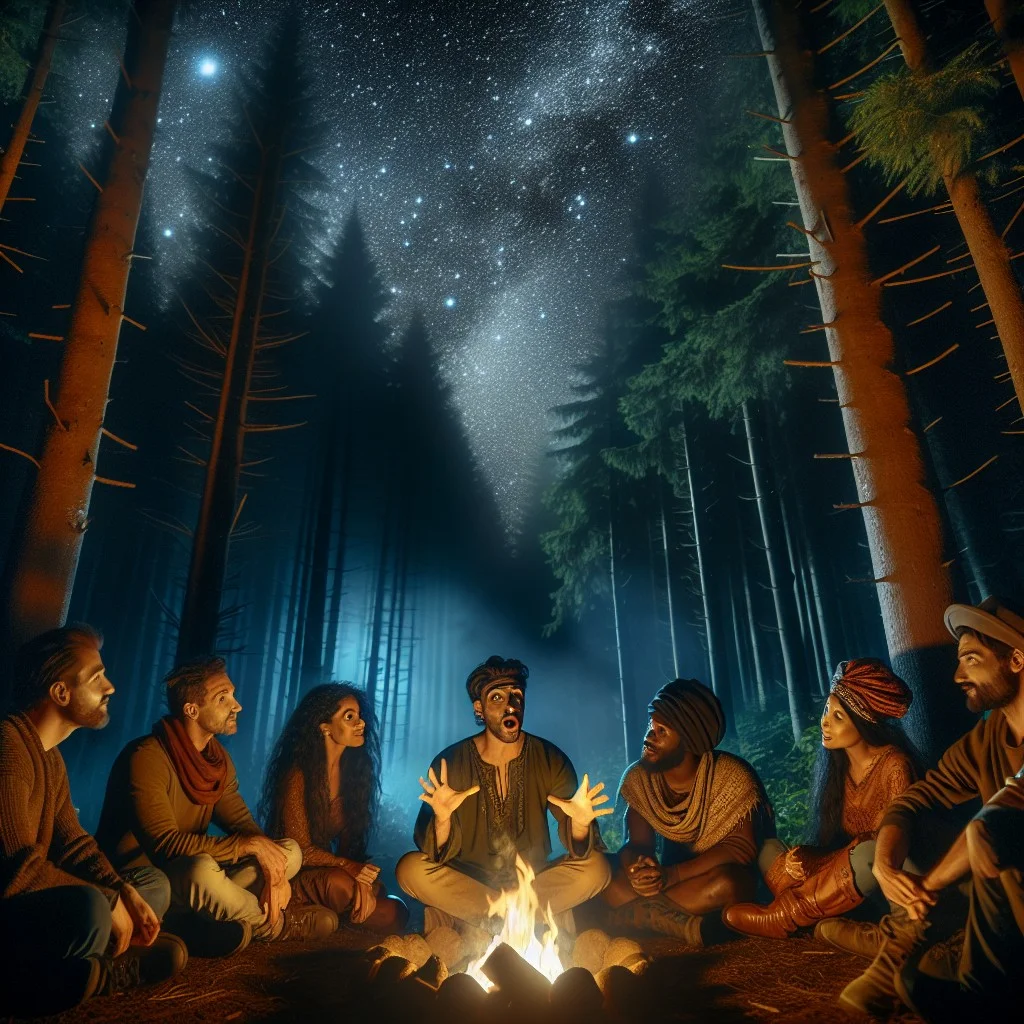
Illuminating flickers from a cozy, warm fire can spark imaginations, making a perfect setting for storytelling. Here are some tips to make your campfire storytelling a unique, enjoyable experience:
1. Prepare in Advance: Have a few tales ready – folk legends, ghost stories, or funny family anecdotes. Rehearse them for better delivery.
2. Engage the Audience: Include interactive elements such as questions, sing-along parts, or roles for attendees. This will make them active participants rather than passive listeners.
3. Use Props: Lanterns, toys, or simply hand gestures can add depth to the narrative, effectively engaging the audience.
4. Practice your Pacing: A good story is all about timing. Strategic pauses can build anticipation, enhancing listener engagement.
5. Speak Clear and Loud: Ensuring everyone hears every word is important. Consider the fire crackles and outdoor noises.
By following these guidelines, your storytelling around the campfire will be a memorable activity during your outdoor adventures.
Wildlife Photography Quest

Embarking on a photography quest can lead to an abundance of interesting subjects right in your backyard where you can capture the beauty of local birds, squirrels, or other wildlife. Here’s how to make the most of it:
1. Equipment: Utilize a camera with a telephoto lens for close-ups from a distance. However, even a phone camera can suffice for beginners.
2. Patience: Wildlife doesn’t work on your schedule. Be patient while waiting for the perfect shot.
3. Safety: Always keep a respectful distance, without disturbing the natural behavior of animals.
4. Light: Natural light is your best friend. Early mornings or late afternoons provide the best lighting conditions.
5. Observation: Study the animals, their patterns, behaviors, and favorite spots in your yard.
6. Creativity: Try different angles and frame your shot in unique ways to create interesting photos.
Remember, the quest is not about capturing the perfect shot, but enjoying nature’s beauty while honing photography skills.
Homemade Bird House Crafting
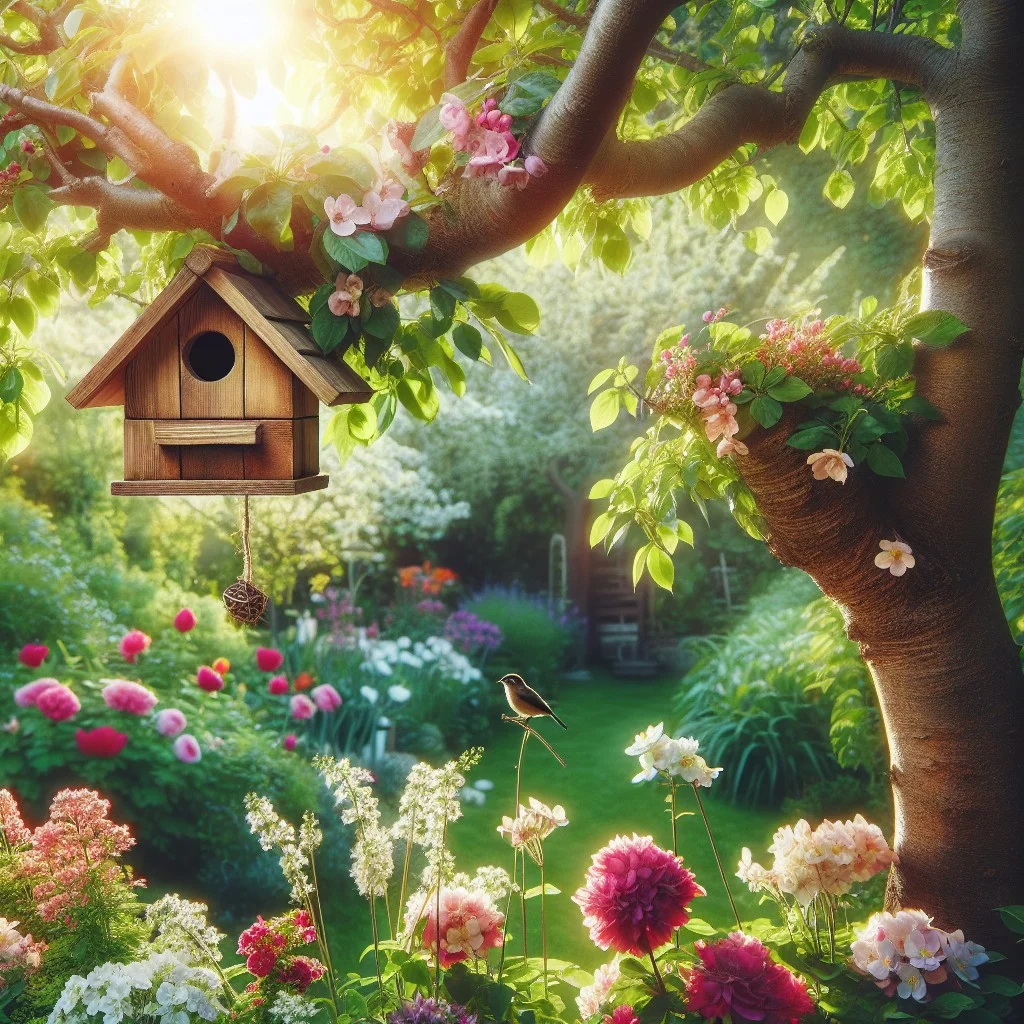
Starting this project can seem daunting, but it’s simpler than it looks! Let’s dive right into the process.
1. Gathering Materials: Look for unused or recycled wood, a saw, hammer, nails, and non-toxic paint for exterior decoration.
2. Designing the House: The design should be simple, with a small entrance for the birds to protect them from predators.
3. Construction: Cut the wood into six pieces – a front, back, two sides, a bottom and top. Ensure the front piece has a small hole for the entrance. Assemble these pieces with nails and hammer.
4. Decorative Touches: Finish off by painting the birdhouse in bright, non-toxic colors that attract birds. Avoid colors that attract predators or overheat the house.
5. Location and Pride: Hang the birdhouse in a quiet, sheltered location. Each visiting bird will fill your heart with joy.
This DIY project not only allows you to tap into your crafting skills but also helps support local wildlife, making it a win-win for everyone involved. Plus, it’s a great way to spend an afternoon outdoors and can be an engaging family activity.
Star Gazing Night

With a blanket, a comfy pillow, and eyes turned towards the sky, embarking on a night-time exploration of cosmos awakens wonder and curiosity in children and adults alike. Following these practical tips can elevate your experience:
1. Finding a Suitable Location: Areas with minimal artificial light provide the best views. Parks, fields, or backyards far from city lights serve as excellent spots.
2. Identifying Constellations: Use stargazing apps or guides to find and learn about different constellations. It’s a fun and informative activity that cultivates a deeper appreciation of the universe.
3. Spotting Planets: Certain planets like Mars, Jupiter, and Venus can be seen with the naked eye at specific times of the year. Tracking schedules of planetary appearances can add more excitement.
4. Meteor Showers: Watching these requires planning as meteor showers happen only a few times a year. Make sure to mark calendars in advance for a celestial light show.
5. Comfort: Ensure a comfortable experience by bringing warm clothes, chairs, or blankets. Hot drinks provide coziness while repelling bugs.
6. Respect for the Environment: Remember to leave no trace, carrying out any rubbish and leaving the stargazing spot as you found it. It’s part of our responsibility to protect our beautiful natural spaces.
Consider star gazing as a natural way to inspire, educate, and create magical memories that will remain as fascinating as the universe itself.
Bug Catching and Studying
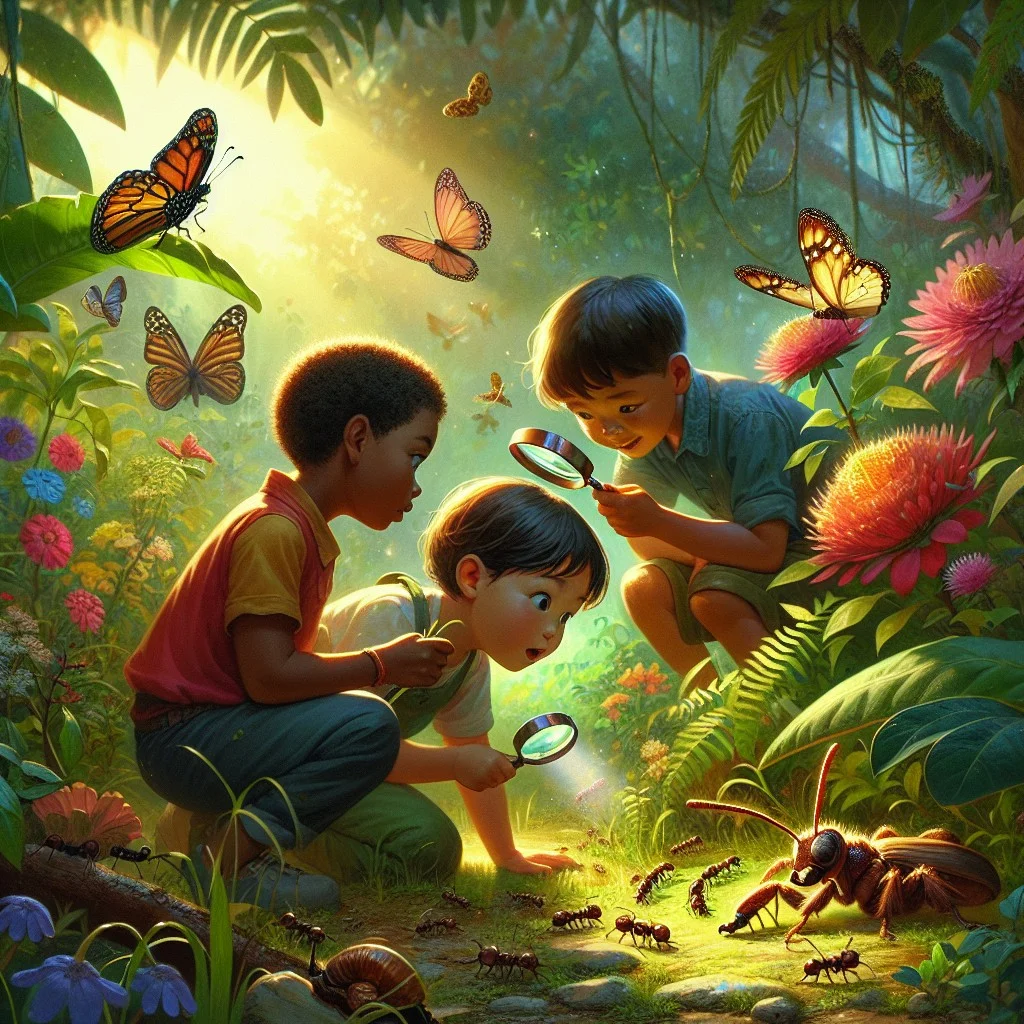
Initiating this activity only requires a magnifying glass and a clear jar with a few holes in the lid. These tools can serve as an exciting springboard for children to learn about the different bug species and their habitats.
There’s an array of bugs to explore in your backyard such as ladybugs, beetles, spiders, or ants.
Remember, the goal isn’t to harm these small lives, but to observe and marvel at their world. Teach children about the importance of each insect in the ecosystem and how their small part plays into the larger world.
The observation period can be recording the bug’s colors, size, the number of legs, their pattern of movement, and any unique features. Afterward, ensure to release the insects safely back into their environment. This activity combines education, adventure, and respect for nature, all wrapped up in one.
For an extended learning experience, collect fallen leaves and twigs to recreate the bug’s natural habitat inside the jar.
Stream Fishing With Homemade Rod

Constructing a fishing rod from natural materials not only enhances the thrill of stream fishing but elevates your connection with nature. Here’s how you can assemble your own rod and get started:
1. Stick Selection: Choose a robust, yet flexible branch, about an arm’s length.
2. Line Attachment: Secure a fishing line to the thick end of the stick, double knotting it for strength.
3. Adding a Hook: Attach a hook to the loose end of your line. Remember, size matters; the hook should be appropriate for the fish in your location.
4. Bait Addition: Choose your bait wisely. Live bait like worms often proves most successful.
5. Casting Technique: Casting needs precision. Ensure your movements are smooth and practiced to avoid scaring away fish.
6. Patience: Stream fishing involves a good deal of waiting. Enjoy the surrounding natural serenity while you wait for a bite.
Armed with your self-made tool and these tips, get ready to explore the joy of stream fishing au naturel!
Cloud Identification Game

To set the stage for this engaging and educational activity, prepare a basic guide on the types of clouds — cumulus, stratus, cirrus, and nimbostratus. A small, laminated cheat sheet can also work as a weather-proof, durable guide during the game. Binoculars can come in handy but are not a necessity.
1. Select a suitable day: Choose a day when the sky is fairly clear yet displaying a healthy smattering of clouds.
2. Design the game: Turn the activity into a fun race by setting a time limit to identify as many types of clouds as possible.
3. Utilize the guide: Use the prepared guide as reference. It can be as detailed or as basic as you feel appropriate, depending on the ages and prior knowledge of the participants.
4. Engage everyone: Ensure all participants are actively involved, even the youngest. They can identify the basic shapes while the older ones or ones with more knowledge can get into specifics.
5. Record findings: Each identified cloud can be marked down on a list. This promotes a bit of friendly competition.
6. Be mindful: Remember to remind everyone not to stare directly at the sun while looking up. Sunglasses can help to protect the eyes.
Creating a cloud identification game not only serves as a good introduction to meteorology but also, more importantly, feeds curiosity about the natural world, all while having fun! Don’t forget to celebrate the ‘cloudologists’ at the end of the game.
Foraging for Edible Plants

Safety should always be prioritized when searching for plants. It’s vital to possess extensive knowledge about plant recognition, as some plants can be dangerous if consumed. Starting with familiar plants like dandelions, mint, and nettle might be advisable for beginners.
Here are some tips:
- Invest in a reliable plant identification guidebook or app.
- Choose an area far from traffic to avoid pollution.
- Never pick all plants in one area; always leave some behind.
- Continually wash your hands and any tools used.
- Avoid plants that have a milky sap; they are often poisonous.
- If in doubt, don’t eat it. This golden rule can save lives.
Protection of endangered species is fundamental. Laws vary on plant picking, so it’s always best to research local rules and regulations.
Remember, foraging should be a process of discovery, connecting more with nature, not just about finding food.
Mud Pie Competition
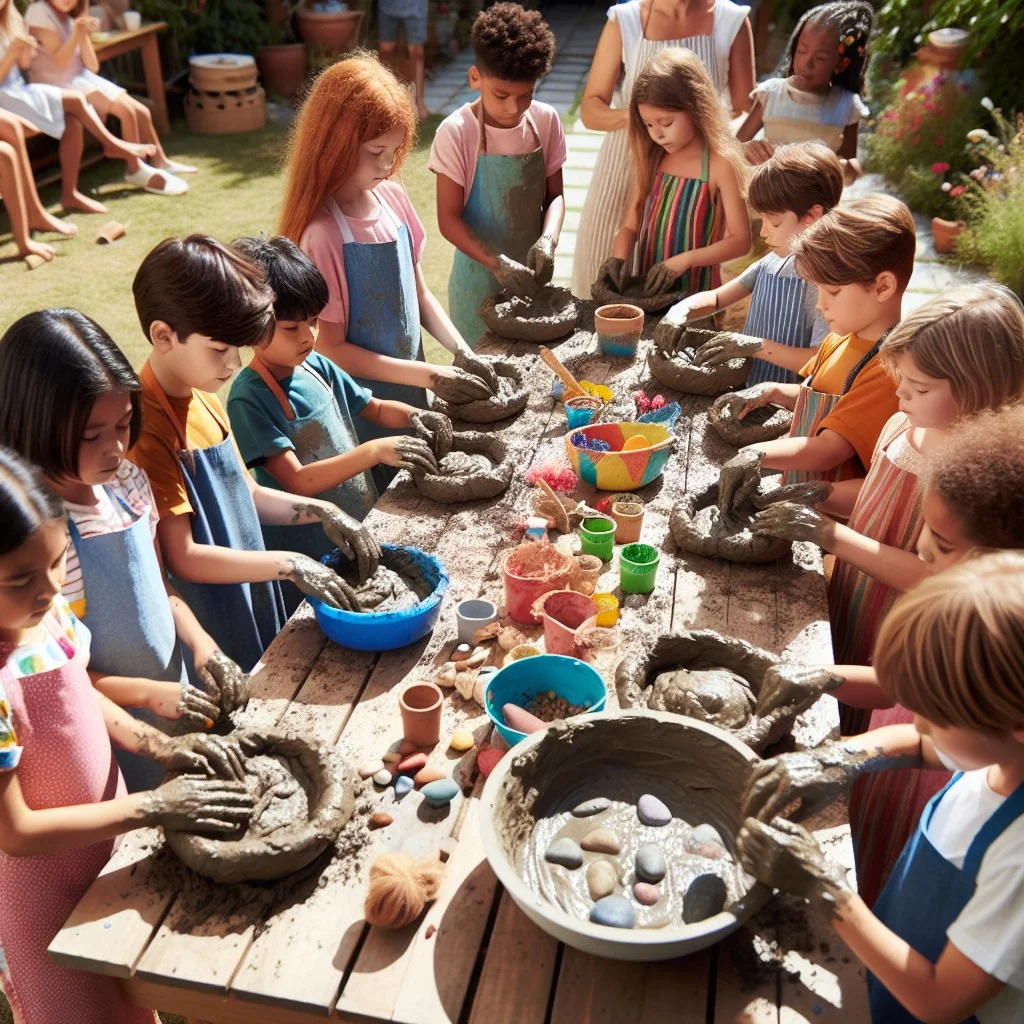
A fun, tactile, and creative activity, the Mud Pie Competition not only lets the kids get dirty without consequence, but it also channels their creativity in a constructive way. Here are some aspects to consider while organising this nature-friendly competition.
1. Location and Preparation: A backyard or a garden with soft earth offers the perfect spot. Ensure it’s allowed to dig in that area, and have buckets of water handy for cleaning purposes.
2. Tools and Decorations: Provide safe utensils like old pans, spoons, buckets and molds. Add a twist by introducing natural décor like pebbles, leaves or flowers.
3. Instructions: Guide children to build their mud pies. They can experiment with adding water to achieve the perfect consistency, and use their fingers to mould and shape their creations.
4. Judging: Have various parameters for judging like creativity, use of natural materials or craftsmanship. Rotate the judges each time to ensure fairness.
Remember its purpose is to have fun, promote creativity and respect for the natural world.
Insect Hotel Construction
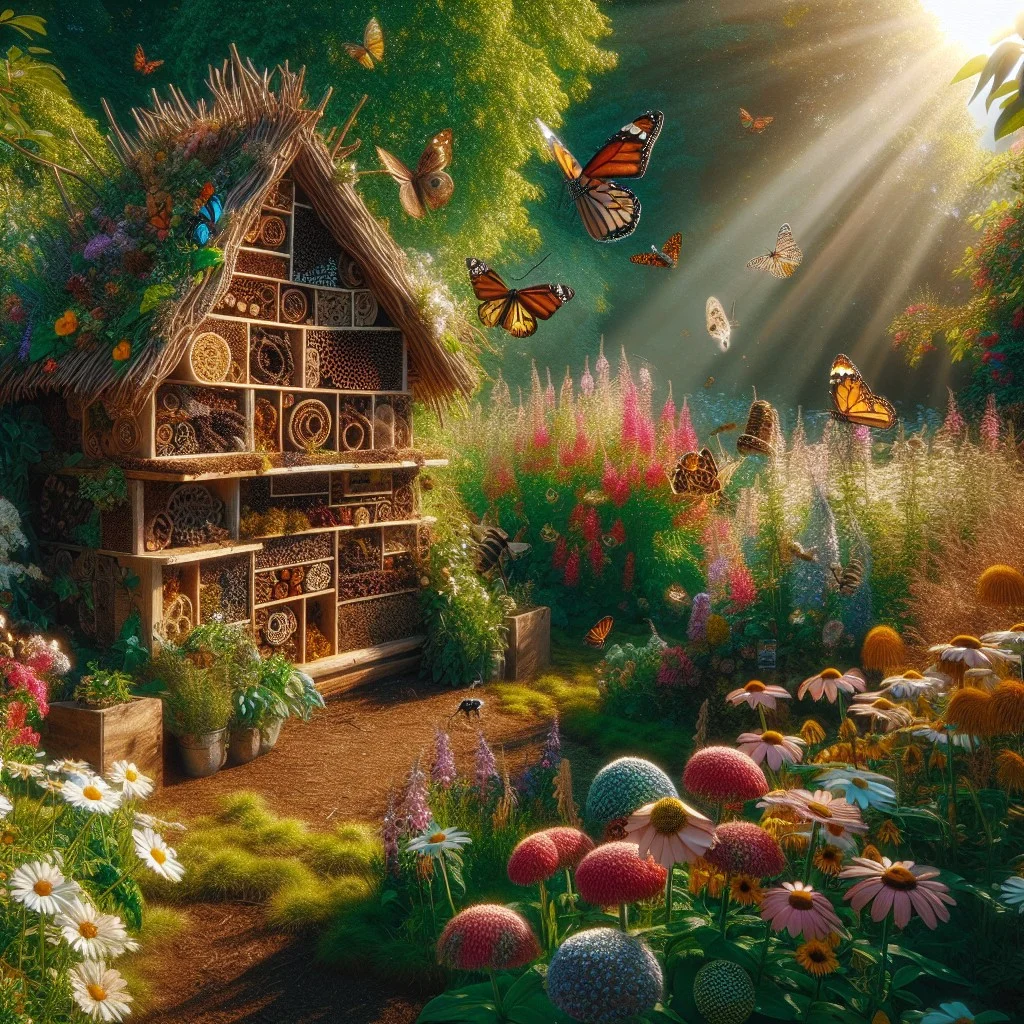
Creating an insect hotel is a fun and educational activity for all age groups.
1. Gather Materials: Start by collecting different organic materials. This might include bark, twigs, bamboo, straw, pine cones, and bricks – the more variety, the better.
2. Selection of Hotel Site: Choose a quiet spot in your garden, ideally a few feet above the ground and not directly exposed to harsh weather conditions.
3. Frame Construction: Use untreated wood to build a simple box frame. Leave one side open for the ‘rooms’.
4. Filling: Fill the open side of your frame with the collected materials. Consider the different sizes and shapes of your fillers to cater to varying insect preferences.
5. In Say Hello to New Inhabitants: Insects such as bees, beetles, and ladybugs will soon find your hotel, offering them a refuge and a place to breed safely.
Remember, patience is key! It might take a little while for the bugs to check-in. Once they do, it’s a wildlife spectacle right in your backyard to enjoy.
Caveman Day – Living Off Nature
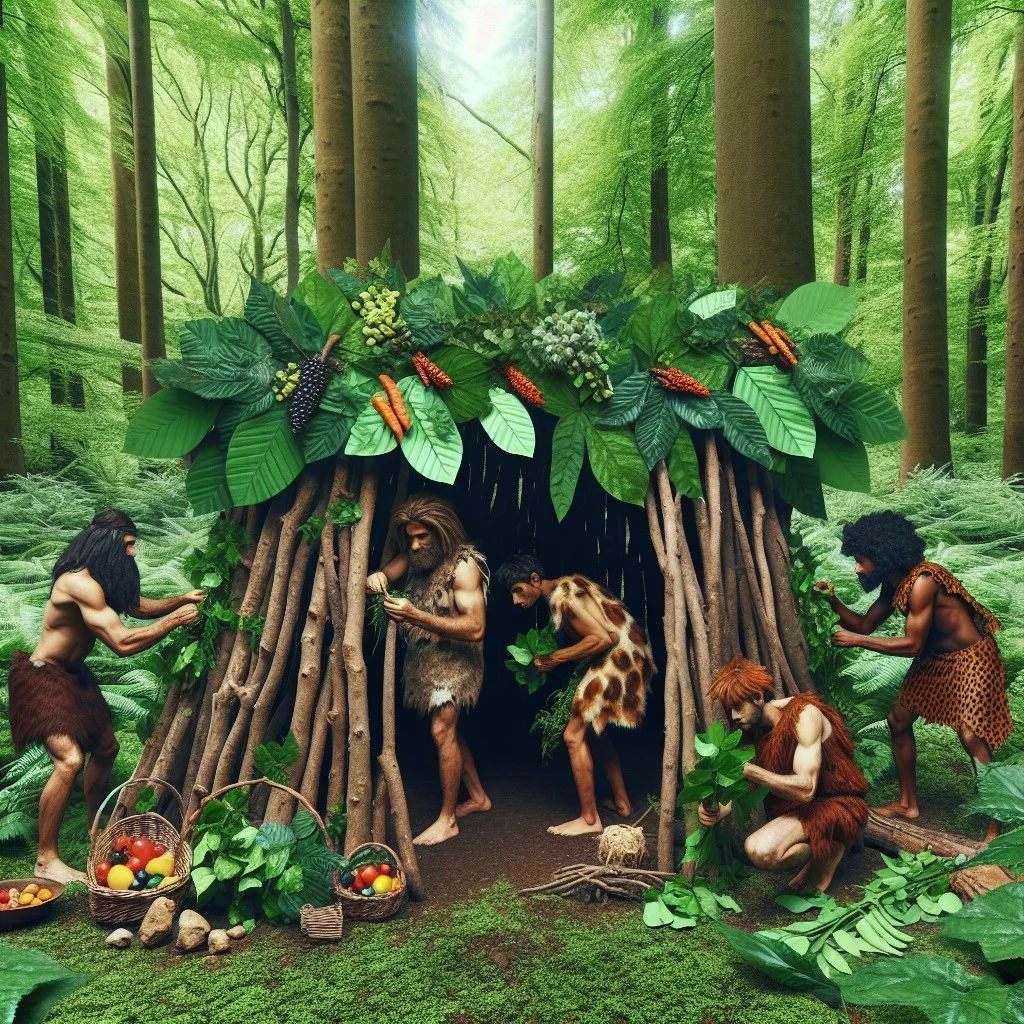
The perfect way to inspire the family to step out of the comforts of modern life is by spending a day range as our ancestors once did. Here’s how to plan it out successfully:
1. Preface the day: Talk with your family about the activities to be performed and what to learn.
2. Start simple: Kick off the day with the basic shelter building using only natural resources. Gather fallen branches, leaves, and other materials to form a rudimentary structure.
3. Forage for meals: Guided by a book or app about safely edible wild plants, strawberries, dandelions, and nuts, explore and collect food for your meals.
4. Fire starting: Show your family how to start a fire without matches or a lighter by using friction. It’s not just useful but also exciting to see sparks generated from simple sticks.
5. Craft making: Use twigs, leaves, and other natural items to make crafts. This could range from jewelry to other useful utensils or even art.
6. Communicate: Teach your family some basic sign language or simple sounds that could have been used in prehistoric times.
Follow these strategies to spend time away from modern technologies, and feel a deeper connection with the world around you. A quick note – always let safety and respect for nature guide your activities.
Outdoors Yoga Fun

Transforming your garden into a haven for relaxation and activity, yoga lends itself perfectly to the outdoors where you can better connect with nature. Here are a few key points to turn your outdoor space into the ultimate yoga sanctuary.
1. Open Space: Ensure there’s ample room to maneuver when striking different poses.
2. Peaceful Surroundings: Plants, water features, or wind chimes can add to a serene atmosphere.
3. Comfortable Surface: Grass or an outdoor mat can offer soft but stable ground.
4. Natural Shade: Consider a spot under a tree or installing a shaded canopy, to protect from direct sunlight and allow yoga sessions at any time of the day.
5. Equipment Storage: Consider a dedicated outdoor storage box for easy access to your yoga mat and other essentials.
Remember, aside from the physical benefits, outdoor yoga can help improve mindfulness and reduce stress, adding an extra layer of enjoyment to your natural playful adventure.
Ideas Elsewhere
- https://thegeniusofplay.org/genius/expert-advice/articles/raising-creative-playful-thinkers.aspx
- https://lumenkind.com/blogs/flow/power-of-being-playful
- https://www.step2.com/kids/kids-toys/sand-water-play
- https://goric.com/naturally-playful-playscapes/
- https://www.step2.com/naturally-playful-storybook-cottage
- https://afineparent.com/positive-parenting-faq/playful-parenting.html
